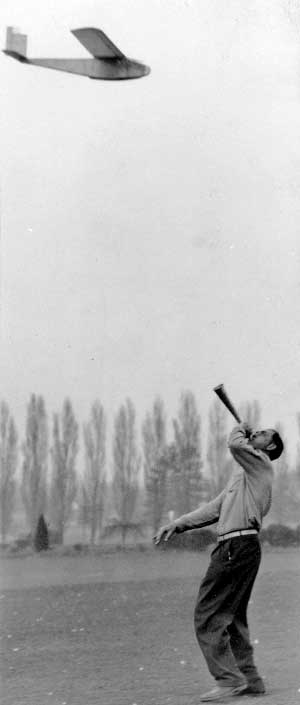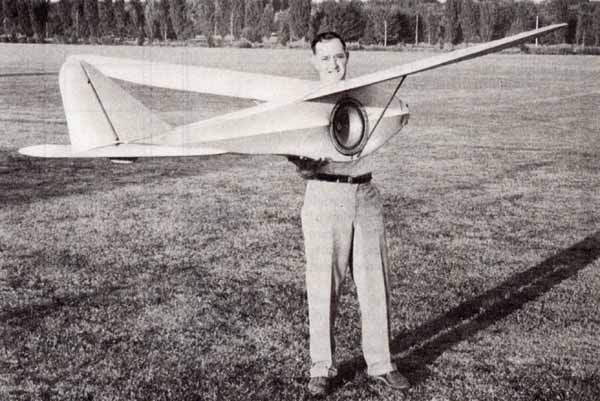
Jim Walker's Sonic Control Glider
Jim Walker was always working on new technologies. He invented a sound-control glider with a diaphram built into its side. Jim ran beneath the glider tooting on a horn, steering the thing about like any R/C rudder job.
 |
Back in the early days of model aviation there was a lot of experimentation. Jim Walker was a pioneer inventor who loved model aviation. He experimented with many ways to control a model airplane in flight. His development of U-Control as a system of control line flying allowed us for the first time to be in direct control of the model plane. Prior to this method of flying, we had to rely on the free flight system with the engine set on a short run to get the model into the air and hope that it was properly adjusted so it would circle the field and land nearby, hardly a system of hands-on control.
Radio control was mostly just a concept at the time Jim Walker was developing his Sonic Control system of flying. The Sonic Controlled model airplane would be lifted into the air by a motor ot tether line and then begin to glide. The plane was equipped with a large speaker which worked like a sensitive microphone listening for commands from Jim. With the beat of a drum or toot of a horn the Sonic Glider would turn that sound into electric impulses that would trigger the hardware on board to turn the plane. Many of us can remember the early days of single channel radio control where all we had was a button to make the plane go full right, full left or straight. This glider worked on much the same principle except through the transmission of sound waves instead of radio waves.
This system worked pretty well in the early 1940's because of the quiet countryside. This would hardly be practical in todays noisy, industrialized environment. There are a lot of fun stories about the Sonic Glider. One such story tells of Jim Walker flying his Sonic Glider in the Portland area of Sauvie Island and it was performing beautifully. Unfortunately it cruised too close to a heard of cows that were busy mooing and the glider tuned into the sounds of the cows and would not respond to Jims' attempts to the plane. The plane danced around the sky and turned with each new moo of a cow. The happy ending is that Jim eventually got the glider down and had another fun tale to tell, just another day in the life of Jim Walker.
Another story involves the trial and error research that Jim Walker put into his sonic control glider: Testing the response of the glider's receiver to various sounds, Jim was in a field close by his house trying out his glider. He was loaded with noise making devices - including whistles, a drum and even a small revolver. When he fired the gun in an empty lot, the nervous neighbors called the cops. Climbing out of the cruiser, the burly arm of the law wanted to know what Walker was up to now? Before long the officer was involved in Jim's experiment. It appears that Jim's little 22 calibur pistol was not loud enough to be an effective control device but the police officer's large 38 calibur shooting iron was. This was evidenced by the emptying of the officer's gun into the air, all in the name of science, of course!
The major problem with sonic control was that of distance. The model must be kept close enough to hear the commands to turn. We have heard many stories from people who were there when the glider got out of range and took off cross country. These stories always included a colorful description of Jim Walker loosing his temper of his when this happened. All we can say is that Jim Walker was a passionate man and his real passion was to promote model aviation in any way he could.
 |